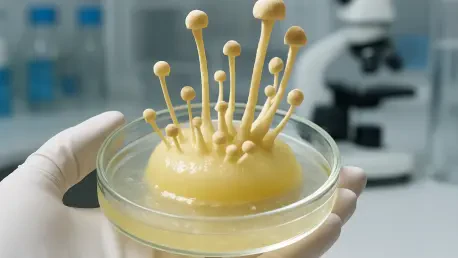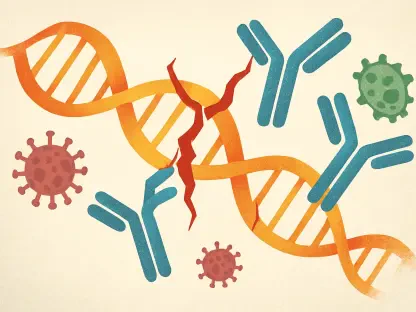Imagine a future where medical materials not only mimic the softness and resilience of human tissue but also heal themselves, all while being sourced directly from nature’s blueprint. At the University of Utah, a groundbreaking discovery has brought this vision closer to reality through fungi-inspired hydrogels derived from the soil fungus Marquandomyces marquandii. Spearheaded by Ph.D. candidate Atul Agrawal and Professor Steven Naleway, this innovation is set to redefine biomedical applications and extend into other industries. Their research, recently published in the journal JOM, unveils a new class of living, water-saturated materials with extraordinary potential. These hydrogels, built from fungal mycelium, hold up to 83% water by volume, offering elasticity and durability that rival synthetic alternatives. Their promise spans tissue engineering, regenerative medicine, and even wearable devices, marking a significant leap in sustainable material science.
Unveiling Nature’s Design
Fungal Inspiration
The foundation of this revolutionary material lies in the intricate, root-like structure of fungal mycelium, specifically from Marquandomyces marquandii. Unlike traditional synthetic hydrogels, which often lack the natural adaptability required for biomedical use, mycelium offers a unique combination of elasticity and resilience. This network of hyphae, the thread-like components of fungi, forms a living matrix that can be cultivated into soft, dynamic hydrogels. These materials outperform many man-made options by naturally responding to stress and strain, a critical factor for applications like tissue scaffolds or medical implants. The inherent properties of mycelium allow it to maintain structural integrity while providing a biocompatible environment, positioning it as a game-changer in the quest for advanced biomaterials. Researchers have tapped into this natural resource to create a material that not only mimics biological systems but also integrates seamlessly with them, opening new pathways for innovation.
The journey to this discovery was anything but straightforward, highlighting the serendipitous nature of scientific exploration. Initially, the team at the University of Utah focused on a hydrocarbon-degrading species dubbed “kerosene fungus” for its potential in environmental cleanup. However, unusual growth patterns in their lab cultures led to the identification of M. marquandii and the unexpected revelation of its hydrogel-forming capabilities. This accidental finding underscores the value of curiosity-driven research in mycology, where unforeseen results can yield transformative outcomes. It also reflects the broader potential hidden within fungi, a kingdom often overlooked in materials science. The shift from environmental applications to biomedical innovation demonstrates how adaptable fungal research can be, encouraging further investigation into other species that might harbor similarly remarkable properties. Such unpredictability in science often paves the way for breakthroughs that reshape entire fields.
Structural Marvels
One of the most striking features of these fungal hydrogels is their multilayered, functionally graded architecture, a design that sets them apart from uniform synthetic gels. With zones of porosity varying between 40% and 90%, this structure effectively distributes mechanical stress, ensuring durability under dynamic conditions. Such a characteristic is vital for biomedical applications where materials must withstand repetitive movements without degrading, as in joint implants or skin-like sensors. The hierarchical arrangement mimics natural tissues, which often exhibit gradients in density and strength to handle diverse physiological demands. This innovative design not only enhances the material’s toughness but also supports specialized functions, such as guiding cell growth in specific patterns for tissue engineering. By emulating nature’s complexity, these hydrogels offer a robust yet flexible solution for modern medical challenges.
Another defining trait of these hydrogels is their exceptional water content, retaining up to 83% water by volume, which closely mirrors the composition of human tissues. This high hydration level contributes to a soft, pliable texture ideal for applications requiring close contact with biological systems, such as wound dressings or organ scaffolds. Beyond mere mimicry, the water-saturated structure enables the material to maintain flexibility while providing a nurturing environment for cells to thrive. This property addresses a long-standing limitation of synthetic materials, which often struggle to balance moisture retention with mechanical stability. In medical contexts, this balance is crucial for ensuring patient comfort and promoting healing processes. The ability to replicate the hydrated nature of living tissues positions fungal hydrogels as a promising frontier for creating more lifelike and effective biomedical solutions.
Biomedical Breakthroughs
Tissue Compatibility
At the heart of these hydrogels’ suitability for medical use is chitin, a natural biopolymer present in fungal mycelium, which offers remarkable biocompatibility. Known for its spongy texture, chitin minimizes the risk of inflammatory responses when integrated with human tissues, a common hurdle with synthetic implants. This compatibility is essential for applications like tissue scaffolds, where the material must coexist with living cells without triggering adverse reactions. The gentle, non-irritating nature of chitin allows these hydrogels to serve as a safe foundation for medical interventions, reducing complications and improving outcomes. As a result, they hold significant promise for advancing treatments that require seamless interaction with the body, paving the way for safer and more effective healthcare solutions.
Beyond mere compatibility, the living nature of fungal hydrogels introduces dynamic capabilities that synthetic materials often lack, such as self-healing and adaptability. These traits enable the material to respond to physical stress by repairing minor damage over time, a feature particularly valuable in long-term implants or wearable devices that endure constant wear. Additionally, their adaptability allows them to adjust to environmental changes within the body, such as shifts in temperature or pressure, ensuring consistent performance. This responsiveness sets them apart from static alternatives, offering a closer approximation to the behavior of natural tissues. For medical professionals, this means the potential for devices and scaffolds that not only last longer but also evolve with the patient’s needs, enhancing recovery and functionality in ways previously unattainable with conventional materials.
Expanding Applications
In the realm of regenerative medicine, fungal hydrogels present a transformative opportunity as scaffolds for tissue repair and cell growth. Their structural integrity and biocompatibility address critical challenges faced by synthetic options, such as insufficient durability and poor integration with biological systems. These materials can support the regeneration of complex tissues by providing a stable yet nurturing framework for cells to proliferate and differentiate. This capability is particularly relevant for treating severe injuries or degenerative conditions, where rebuilding damaged organs or tissues remains a significant obstacle. By fostering controlled cellular environments through their multilayered design, these hydrogels could redefine approaches to healing, offering hope for more effective therapies that closely emulate the body’s natural repair mechanisms.
The versatility of fungal hydrogels extends far beyond healthcare, with their flexibility and impressive strength-to-weight ratio unlocking applications in diverse fields like wearable technology, aerospace, and agriculture. In medical wearables, their resilience allows for the creation of sensors that conform to bodily movements without degrading, ensuring accurate monitoring over extended periods. Meanwhile, in aerospace, the lightweight yet durable nature of mycelium-based materials could contribute to more efficient designs for components requiring high performance under stress. In agriculture, their potential to form sustainable substrates offers innovative solutions for eco-friendly farming practices. Backed by funding from prominent organizations like the U.S. National Science Foundation and the American Chemical Society, ongoing research into other fungal species hints at even broader possibilities, blending nature’s ingenuity with cutting-edge advancements across industries.
Sustainable Horizons
Reflecting on the strides made, the development of fungal hydrogels at the University of Utah marked a pivotal moment in materials science history. The team’s exploration of Marquandomyces marquandii yielded living materials that surpassed synthetic counterparts in elasticity, resilience, and tissue compatibility. Their impact was felt across regenerative medicine, where they supported tissue repair, and in wearable technology, where they enabled adaptive devices. Even industries like aerospace and agriculture saw potential in their sustainable, lightweight properties. The unexpected nature of this discovery, born from an unrelated environmental study, highlighted the profound value of open-ended research. Moving forward, the focus should shift to scaling production methods and exploring additional fungal species for tailored applications. Collaborations between scientists and industry leaders will be key to integrating these biomaterials into everyday solutions, ensuring that nature-inspired innovation continues to address global challenges with sustainable, high-performance answers.









